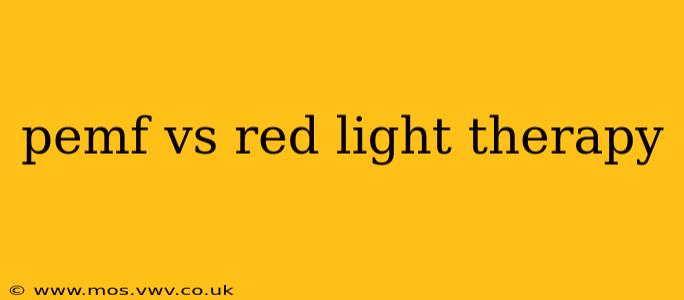Both Pulsed Electromagnetic Field (PEMF) therapy and red light therapy (RLT) are gaining popularity as alternative treatments for various health conditions. But how do they compare, and which one is better for you? Understanding the mechanisms, benefits, and limitations of each therapy is crucial for making an informed decision. This in-depth comparison will explore the key differences and help you determine which approach might be most suitable for your needs.
What is Pulsed Electromagnetic Field (PEMF) Therapy?
PEMF therapy uses electromagnetic fields to stimulate cells in the body. These pulsed fields generate low-level electromagnetic energy that penetrates tissues, potentially influencing cellular processes at a fundamental level. Proponents suggest this stimulation can reduce inflammation, improve circulation, and promote healing. The devices used vary, from small, handheld units to larger, more powerful systems. Treatment involves placing the device near the affected area for a specified duration.
What is Red Light Therapy (RLT)?
Red light therapy utilizes low-level light emitting diodes (LEDs) to deliver red and near-infrared light to the skin. This light energy is believed to penetrate the skin, stimulating cellular activity, promoting collagen production, and reducing inflammation. Unlike PEMF therapy which uses electromagnetic fields, RLT directly interacts with cellular components using light. RLT devices range from small handheld wands to larger panels. Treatments involve exposing the target area to the light for a specific time.
How Do PEMF and Red Light Therapy Differ?
The fundamental difference lies in the type of energy used. PEMF therapy uses electromagnetic fields, while RLT employs light energy. This distinction leads to variations in their mechanisms of action, potential benefits, and applications.
PEMF Therapy Mechanism:
PEMF devices generate pulsed electromagnetic fields that interact with the body's electrical systems. This interaction is thought to influence cellular processes, potentially leading to improved blood flow, reduced inflammation, and accelerated tissue repair.
Red Light Therapy Mechanism:
RLT uses photons of light that are absorbed by photoreceptors within cells. This absorption triggers various cellular processes, such as increased ATP production (cellular energy), stimulation of collagen synthesis, and modulation of inflammatory pathways.
What are the Benefits of PEMF Therapy?
- Pain Management: Many studies suggest PEMF therapy can effectively alleviate pain associated with various conditions, including arthritis, back pain, and fibromyalgia.
- Improved Circulation: The electromagnetic pulses may help improve blood flow, potentially aiding in tissue healing and reducing inflammation.
- Wound Healing: Some research indicates that PEMF therapy can accelerate wound healing by stimulating cell regeneration.
- Bone Density: Studies suggest a potential benefit in improving bone density in individuals with osteoporosis.
- Sleep Improvement: Anecdotal evidence and some small studies suggest a positive impact on sleep quality.
What are the Benefits of Red Light Therapy?
- Skin Rejuvenation: RLT is widely used to improve skin texture, reduce wrinkles, and promote collagen production for anti-aging effects.
- Wound Healing: Similar to PEMF, RLT shows promise in accelerating wound healing by stimulating cell growth and reducing inflammation.
- Pain Relief: RLT can provide pain relief for certain conditions, such as arthritis and muscle soreness.
- Hair Growth: Some studies suggest RLT may stimulate hair follicle activity and promote hair growth.
- Muscle Recovery: It's believed to aid muscle recovery after intense physical activity by reducing inflammation and soreness.
Which is Better: PEMF or Red Light Therapy?
There's no single "better" therapy. The optimal choice depends on individual needs and the specific health condition being addressed. PEMF therapy may be more effective for conditions affecting deeper tissues and those involving bone or nerve issues. RLT, with its focused light energy, might be more suitable for skin-related problems, superficial wounds, or muscle soreness. Both therapies are considered safe when used as directed, but consulting with a healthcare professional is always recommended before starting any treatment.
Can I Use PEMF and Red Light Therapy Together?
There is limited research directly examining the combined effects of PEMF and RLT. However, theoretically, combining these therapies might offer synergistic benefits, as they target different cellular processes but share some common therapeutic effects (like anti-inflammation and improved circulation). However, always consult a healthcare professional before combining treatments.
What are the Potential Side Effects of PEMF Therapy?
PEMF therapy is generally considered safe, but some individuals may experience mild side effects, such as:
- Skin irritation: In rare cases, direct contact with the device may cause minor skin irritation.
- Headache: Some individuals may experience mild headaches, typically resolving on their own.
- Dizziness: Dizziness is a less common side effect.
What are the Potential Side Effects of Red Light Therapy?
Red light therapy is also generally safe, but potential side effects include:
- Temporary redness: Mild redness of the treated area is possible, typically subsiding within a short time.
- Eye irritation: Protecting the eyes is crucial, as direct exposure to the light can cause temporary discomfort or irritation.
Is PEMF Therapy FDA Approved?
PEMF devices are not generally FDA-approved for specific medical conditions, but the FDA does regulate them as medical devices. This means the devices must meet certain safety standards, but it doesn't signify approval for specific therapeutic claims.
Is Red Light Therapy FDA Approved?
Similar to PEMF therapy, RLT devices are FDA-regulated as medical devices but aren't typically FDA-approved for specific therapeutic indications. However, some FDA-cleared devices exist for specific purposes, like treating acne or wound healing.
This information is for educational purposes only and is not intended as medical advice. Always consult with a healthcare professional to determine the appropriate treatment for your specific health condition.
